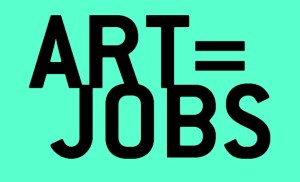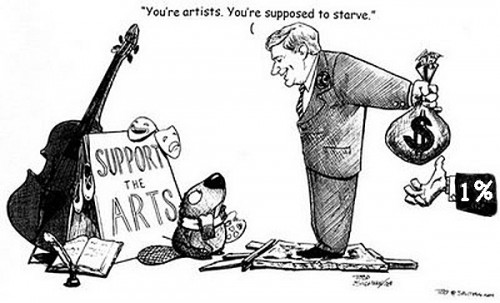Arts and Culture Demonized
Government Support for Arts Declining
By: Larry Murray - Mar 12, 2013
As the anti-intellectual and anti-arts faction of America’s political establishment finds votes in demonizing America’s cultural legacy and heritage, government support for the arts has continued to decline. Nevertheless, even the small amounts earmarked for our performing and visual arts nonprofits, (never more than a tiny fraction of one percent of overall spending) has led to an arts and cultural golden period for America. The focus of the arts worldwide shifted when America began supporting the arts, largely due to the multiplier effect. Arts organizations have become adept at using this support as a way to raise matching funds from their own audiences.
That could all be lost if attempts to starve or silence those who create new art succeeds. As I wrote in Part One, it has been shown that for each dollar that a state, like Oklahoma, invests in their local arts, six dollars in new tax revenue is created because arts funding is not a subsidy, it is a catalyst for economic development. I see it as an investment that pays dividends in new revenues, employment and quality of life.
So let’s look at some facts.
The basics. Government grant funding for the arts in the United States originates from three primary sources: federal appropriations to the National Endowment for the Arts (NEA), legislative appropriations to the nation’s state arts agencies, and direct expenditures on the arts by local governments. All three public funding streams have experienced declines in the past decade, reflecting a recessionary economy and stagnant (or in some cases even declining) public revenues.
2012 Funding Levels
FY 2012 continued the overall trend of decline. The federal government, states, and localities appropriated a combined $1.12 billion to the arts in FY 2012, for a total per capita investment of $3.82 per person. Comprising this total was:
$146 million in appropriations to the NEA, a decline of almost 6 percent from 2011
$260 million in legislative appropriations to state and jurisdictional arts agencies, a decline of about 5 percent from 2011
An estimated $706 million in direct expenditures on the arts by county and municipal governments, a decline of around 3 percent from 2010.
Over the past 20 years, total public funding for the arts by federal, state, and local governments increased by 12 percent. Each layer of government, however, has displayed a slightly different pattern. These patterns are further illuminated by examining both 20-year and 5-year trends:
Local government funding for the arts grew by 33 percent between 1992 and 2002 and reached an all-time high of $858 million in 2008. Since 2008, local government funding has decreased by 18 percent, close to 1998 spending levels.
Appropriations to state arts agencies grew by 110 percent between 1992 and 2001, reaching an all-time high of $450.6 million in 2001 before decreasing to $354 million in 2008. Since 2008, state appropriations have decreased by 27 percent, close to 1996 spending levels.
Federal funding for the arts has been the smallest part of the public funding total and has been less volatile over time. Although NEA funding has fluctuated since 2008, the 2012 budget is less than 1 percent changed from the 2008 budget. In 1996, Congress cut the NEA’s budget by more than 40 percent from the high point of $176 million in 1992. Federal arts support has not fully recovered from that decrease in the two decades since. The greatest percentage of growth over a similar span of four years was the 28 percent increase in arts funding built up between 2005 and 2010. In the past two years, small cuts have set the NEA budget back to its current level of $146 million.
In addition to exhibiting reductions in aggregate terms, public funding for the arts has not kept pace with the cost of doing business. When adjusted for inflation, total government funding for the arts has contracted by 31 percent since 1992; congressional appropriations to the NEA declined by an inflation-adjusted 49 percent between 1992 and 2012. State funding declined by 25 percent and local funding declined by 28 percent during that same period. (Source: Grantmakers in the Arts)
One has to conclude from the deadlock over deficit reduction vs. stimulus that corporations like the high unemployment just fine, it helps keep wages down. In the red states, they love the low cost of labor and desperate need for jobs that makes them more competitive with the blue states which have a better safety net. Workers are more docile where they are not able to fully defend themselves against the abuses of corporate America. So the efforts by one political party to couple spending reductions with yet more tax cuts for the rich results in a net benefit of zero in the deficit reduction game. if Bowles and Simpson are so serious about reducing the deficit, why does their deficit reduction plan include tax cuts?
It’s a charade. To them, recovery from an economy the Bush administration left in ashes is not really the priority. But I digress.
Economic Recovery Essential
Putting people back to work and returning to the business of innovation is important to all of us.
When examined over the last 45 years, arts funding typically has rebounded in the wake of economic recovery. However, continued economic uncertainty, structural weaknesses in public financing systems, and political uncertainty complicate predictions for future public funding of the arts. Due to the well-documented lag of public-sector budget recoveries, few government arts agencies are expecting rapid resource rebounds in the near future. Federal trends can be affected by national fiscal policy, which has the potential to adjust dramatically in an election year. The prospect of federal budget sequestration further clouds the near-term horizon, since the ripple effects of federal sequestration will be felt across all three tiers of government.
Nevertheless, some modestly encouraging news is developing for public arts funding in 2013. Ignoring Kansas and Oklahoma (and several others) state legislatures increased total appropriations to the arts by 8.8 percent for the new fiscal year, and 14 agencies expect budget increases of 10 percent or more. While this is potentially positive news for the sector, the median percentage increase for all states was 0.5 percent (less than inflation), meaning we’ll need more data before knowing whether or not this turnaround has momentum. Since both state and local government budgets have followed economic conditions as reflected in longitudinal data on public arts funding, a turnaround in 2013 local arts expenditures could signal a more robust recovery.
Overall, consideration of current data along with current economic and political situations reflects a time of uncertainty for future public funding for the arts. These considerations underline the need to ascertain not only public funding levels but also how federal, state, and local agencies have adjusted to funding cuts. Monitoring both funding trends and structural adjustments to arts agencies and organizations will allow the field to continue to understand the implications of public funding cuts over time.
Sequester and the Blame Game
Even as I write this the sequester is going into effect, and the blame game continues in DC.
Here in the Berkshires, our cultural organizations have tightened their belts, the show must go on, and it turns out that the low level of support art organizations receive from Government enable them to continue on, their earned income and support from their own constituencies enabling them to weather this fiscal storm. It means we will see a whole lot of one and two character plays with only one set. Those companies unable to scale down their expenses do so at real peril. The past four years have seen more performing groups than usual shut down due to unsustainable deficits. Orchestras and ballet companies have been particularly hard hit. And the Living Theatre in New York was done is just this week by a rent increase.
Massachusetts which is in the top ten states that support the arts at least makes a valiant effort to not only provide annual grants for specific outreach programs, but has found ways to help with infrastructure improvements as well, much needed in a county where the arts have had a major impact for decades, and many buildings are growing older with each passing year and making access for the handicapped can not be put off any longer.
Nowhere in the Commonwealth is the synergy between government and the arts more clearly at work. Walking through one of Tanglewood’s parking lots on a summer evening reveals thousands of cars with out of state license plates, cars that have been refueled while in the Berkshires, its passengers fed and housed locally, and its unique shops patronized. Hundreds of local electricians, plumbers,landscapers and carpenters are employed to help these operations run smoothly. Of course, the local and state governments realize income through the taxes collected on that gas, meals and lodging, income taxes paid by the actors, musicians and dancers, and others. With continued public and private support, there is every reason to expect that continuing to nurture the arts will not only enrich our own lives, but also bring further economic development to this, the most rural of the state’s counties.
Part of a Series on the Economy and the Arts in Berkshire on Stage. Reposted with permission.




